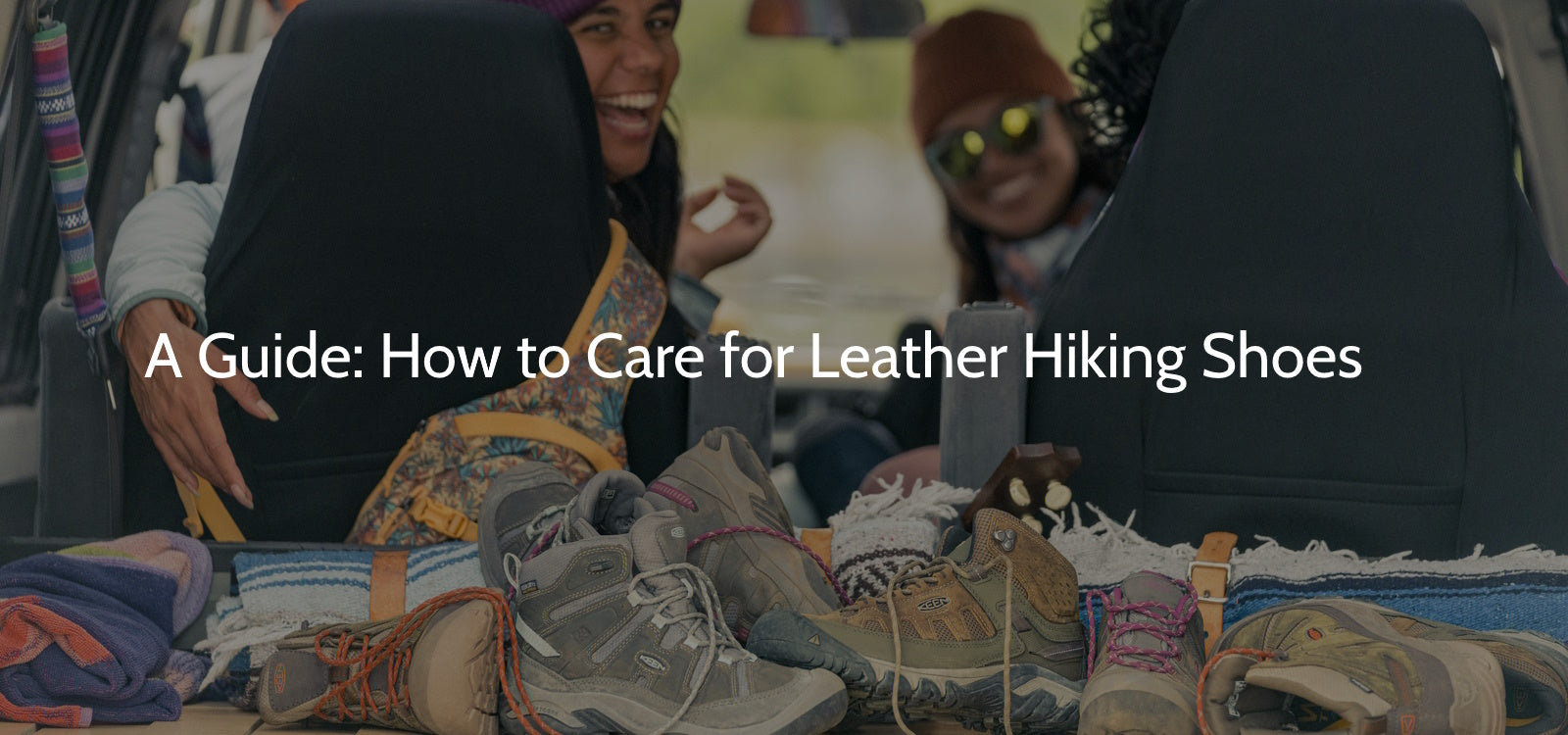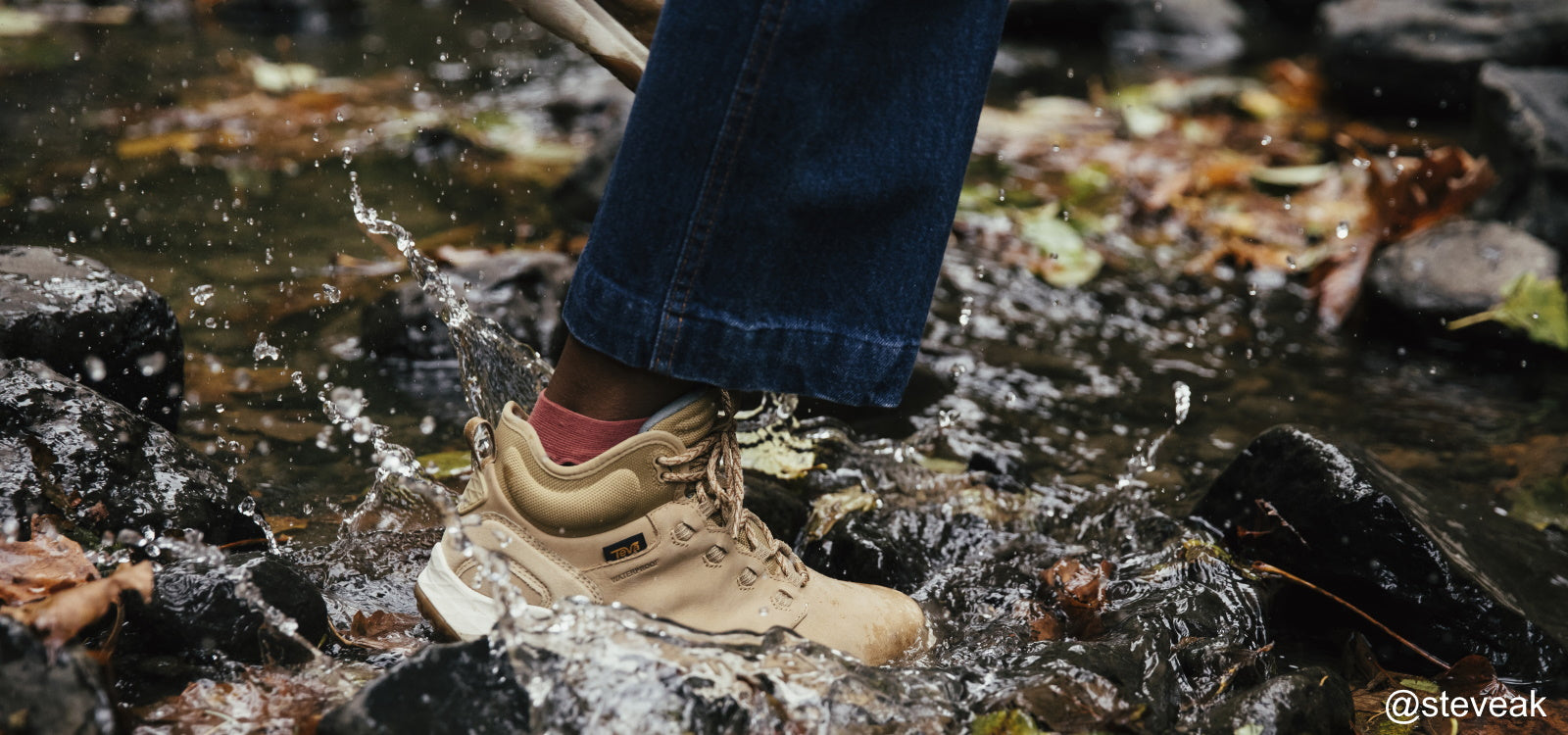Womens *
Mens *
A Guide: How to Care for Leather Hiking Shoes
5 min read
1 Comment
Leather hiking shoes are a crucial piece of gear for outdoor enthusiasts. They offer the perfect balance of durability, support, and comfort, making them an ideal choice for the rugged terrain and varying conditions you encounter on the trail. However, to ensure your leather hiking shoes remain in top condition and provide the performance you expect, proper care and maintenance are essential. In this guide, we'll take you through the steps of caring for your leather hiking shoes, from cleaning and conditioning to protecting and storing them. With the right care, your trusty hiking companions can accompany you on countless adventures.
Why Leather Hiking Shoe Care Matters
Before we delve into the practical aspects of leather hiking shoe care, it's crucial to understand why it is so important. Leather is a natural material that requires proper maintenance to maintain its structural integrity, water resistance, and overall performance. Neglecting your leather hiking shoes can lead to issues such as cracking, drying out, water leakage, and the breakdown of stitching and adhesives. Regular care helps preserve the leather's durability, flexibility, and aesthetic appeal, ensuring your investment in high-quality hiking shoes pays off long term.

Tools and Materials You'll Need
Before we get started, gather the necessary tools and materials:
-
Soft Bristle Brush: A soft brush is essential for removing loose dirt and debris from the shoe's surface without scratching the leather.
-
Leather Cleaner: Choose a leather-specific cleaner suitable for hiking shoes, a robust formula to remove dirt, mud and sweat. Brands such as Grangers or Nikwax
-
Conditioner: These conditioners hydrate the leather to provide additional waterproofing and durability for outdoor use.
-
Polishing Cloths: Soft, lint-free cloths are crucial for applying cleaner and conditioner and for buffing your boots.
-
Waterproofing Wax or Spray: These products enhance water resistance and should be chosen according to your boot's specific type of leather.
-
Boot Brush: A boot brush with sturdy bristles can help scrub off stubborn dirt and mud from the outsoles.
-
Laces: If your boot laces are worn or frayed, consider replacing them with high-quality, hiking-specific laces.
-
Boot Trees: Boot trees help maintain the shape of your boots and absorb moisture. While not mandatory, they are a valuable addition to your care routine.
Step 1: Cleaning Your Leather Hiking Shoes
The first step in leather hiking shoe care is cleaning. Here's how to do it:
-
Remove Loose Dirt: Use a soft brush to gently remove loose dirt, mud, and debris from the surface of your boots. Pay extra attention to the outsoles and crevices.
-
Prepare Leather Cleaner: Follow the manufacturer's instructions to prepare your leather cleaner. Some cleaners may require dilution.
-
Apply Cleaner: Using a cloth or sponge, apply the leather cleaner to the entire boot, focusing on areas that have accumulated dirt and stains. Use a circular motion to gently work in the cleaner.
-
Wipe Clean: Allow the cleaner to sit for a few minutes, as specified by the product's instructions. Then, use a fresh cloth or sponge to wipe away the cleaner and the loosened dirt. Repeat the process if necessary.
-
Dry Naturally: Allow your boots to air dry at room temperature. Do not expose them to direct sunlight or artificial heat sources, as this can cause the leather to dry out and potentially crack.
Step 2: Conditioning Your Leather Hiking Shoes
To maintain the flexibility and water resistance of your hiking boots, conditioning is essential. Follow these steps:
-
Choose the Right Conditioner: Select a leather conditioner formulated for hiking boots, as they often need additional waterproofing and durability.
-
Test a Small Area: Before applying the conditioner to the entire boot, test it on a small, inconspicuous area to ensure it doesn't alter the colour or texture of the leather.
-
Apply Conditioner: Using a soft cloth or sponge, apply a thin layer of conditioner to the entire boot. Concentrate on areas that experience the most wear, such as the toe and heel. Gently rub the conditioner into the leather using a circular motion.
-
Wipe Off Excess: Allow the conditioner to absorb into the leather for a few minutes. Then, use a clean, dry cloth to wipe off any excess conditioner.
Step 3: Waterproofing Leather Hiking Shoes
Leather hiking boots are often exposed to wet and muddy conditions. Proper waterproofing is crucial to maintain their performance. Here's how to protect your boots from water damage:
-
Choose the Right Waterproofing Product: Select a waterproofing wax or spray designed for your specific type of leather. Follow the product's instructions closely.
-
Apply Waterproofing: With clean, dry boots, evenly apply the waterproofing product, paying extra attention to seams, stitching, and flex points. Ensure an even coating and let the product dry as per the manufacturer's recommendations.
-
Reapply as Needed: Depending on the frequency and intensity of your hikes, you may need to reapply waterproofing periodically to maintain its effectiveness.
Step 4: Storing Leather Hiking Shoes
Proper storage helps your hiking boots maintain their shape and performance over time. Here are some storage tips:
-
Use Boot Trees: Boot trees help your boots maintain their shape and absorb moisture. They are especially valuable if your boots get wet on your hikes.
-
Store in a Cool, Dry Place: Keep your boots in a well-ventilated area, away from direct sunlight, artificial heat sources, and excessive moisture. Use breathable storage bags to protect your boots from dust while allowing air circulation.

Common Issues
Even with proper care, leather hiking boots can encounter common issues. Here's how to address them:
-
Scratches and Scuffs: Minor scuffs and scratches can be lessened by applying a leather conditioner or wax. For deeper marks, consider using a leather repair kit to patch and restore the area.
-
Salt Stains: To remove salt stains from your boots, mix equal parts white vinegar and water. Dampen a cloth with the mixture and gently wipe the stains. Allow your boots to dry naturally.
-
Creases: To prevent creases and extend the life of your boots, use boot trees consistently, clean and condition boots, especially after wet hikes.
-
Odour: Place cedar boot trees in your boots when storing them to help absorb moisture and eliminate odours. You can also use specialized boot deodorizers.
-
Fading: Protect your boots from direct sunlight to prevent fading. If fading occurs, you can use a leather dye specifically designed for hiking boots to restore colour.
- Soles Crumbling: Use or loose them especially in humid climates. Storing any footwear especially hiking boots in the closet for long periods of time may result in the sole crumbling or falling off. To avoid this, get outside and enjoy some adventures, regular use can prevents this from occurring.
Adventures Await
Leather hiking shoes are your trusted companions on outdoor adventures, and with the right care, they'll continue to provide comfort, support, and protection for many hikes to come. Whether you're tackling challenging trails or enjoying leisurely strolls through nature, your well-maintained leather hiking shoes will help you make the most of your outdoor experiences.
Investing time and effort into leather hiking shoe care ensures they'll be ready for every new adventure, no matter where the trail leads. So, remember to clean, condition, waterproof, and store your hiking boots, and they'll reward you with unwavering performance and reliability in the great outdoors. Your hiking shoes aren't just gear; they're an integral part of your journey and the memories you create along the way.
Looking for your own pair of Leather Hiking Boots? Check out The Urban Gear range of leather boots and shoes today!
1 Response
Leave a comment
Comments will be approved before showing up.
Recent Articles
-
Holiday Gift Guide: Perfect Gifts Under $50
November 11, 2024
-
A Smash Hit on the Court: OluKai 'Anau Pickle Ball Shoes
October 29, 2024
-
Packing for Your Snowy Holidays
June 14, 2024
-
Maximize Your Luggage: The Benefits of Using Packing Cells
June 07, 2024
-
The Art of Packing: Tips and Tricks for the Savvy Adventurer
May 30, 2024
-
Stay Warm and Stylish with XTM Merino Wool and Fleece Beanies
May 13, 2024
-
KEEN Versacore Waterproof Hiking Shoe: An Overview
April 05, 2024
-
Step Up Your Golf Game with OluKai's New Leather Spikeless Golf Shoes
February 22, 2024
-
How to Care for Merino Wool Blended Socks, Clothing, and Gear
October 20, 2023
-
A Guide: How to Care for Leather Hiking Shoes
October 20, 2023
Categories
- Arcade Belts
- BlackWolf
- care for your feet
- care instructions
- creativity
- down
- Eco-friendly
- explore your own backyard
- Golf
- Grangers
- healthy lifestyle
- Holidays
- how-to
- jackets
- KEEN
- Keen Footwear
- Kuhl
- leather
- Merino Wool
- Nalgene Bottles
- OluKai
- Outdoor Slippers
- QLD Hikes
- Rumpl
- Sandals
- Sea to Summit
- shoes
- Slippers
- smartwool
- Smartwool Socks
- socks
- Summer
- Teva
- Ticket to the Moon
- UNEEK
- urban adventuring
- Wool
- XTM
Subscribe
Sign up to get the latest on sales, new releases and more …

Holiday Gift Guide: Perfect Gifts Under $50
4 min read
With the Holiday season just around the corner, finding the perfect gift for your loved ones, colleges, and friends can be a daunting task. That's why the Urban Gear team has come up with an selection of affordable gifts that are sure to impress.

Packing for Your Snowy Holidays
5 min read




sophiyaginger
October 08, 2021
You have chosen an impossible idea and made it possible for the common person to see and believe. You have done a great job on this article. Thank You.